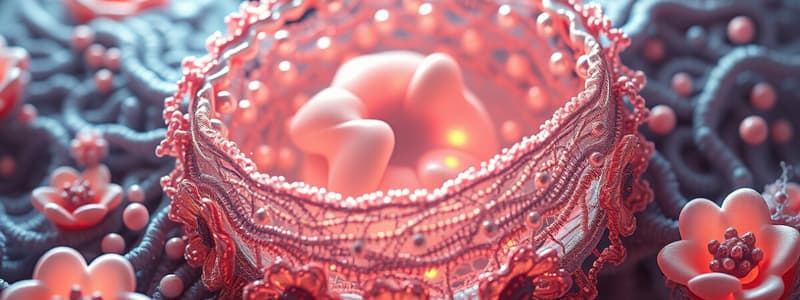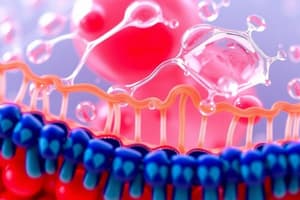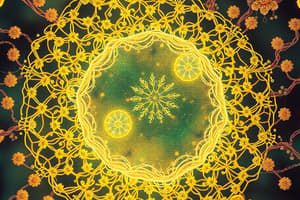Podcast
Questions and Answers
What is the primary function of carrier proteins in passive transport?
What is the primary function of carrier proteins in passive transport?
- To selectively allow water to pass through the membrane.
- To form vesicles for bulk transport of substances into the cell.
- To facilitate the movement of specific molecules across a membrane through conformational changes. (correct)
- To use energy for transporting molecules against their concentration gradient.
In osmosis, the movement of water is primarily determined by what factor?
In osmosis, the movement of water is primarily determined by what factor?
- The presence of active transport mechanisms.
- The temperature of the solution.
- The size of the water molecules in the solution.
- The relative concentration of solute on either side of the membrane. (correct)
What characterizes active transport compared to passive transport?
What characterizes active transport compared to passive transport?
- It occurs without energy expenditure irrespective of the electrochemical gradient.
- It requires energy to move molecules against their electrochemical gradient. (correct)
- It exclusively transports large molecules through vesicles.
- It is limited to the passive movement of ions through ion channels.
Which component is NOT involved in exocytosis?
Which component is NOT involved in exocytosis?
Endocytosis can encompass various forms. Which of the following describes phagocytosis?
Endocytosis can encompass various forms. Which of the following describes phagocytosis?
What is the role of the Na+-K+ pump in cellular transport?
What is the role of the Na+-K+ pump in cellular transport?
What distinguishes receptor-mediated endocytosis from other forms of endocytosis?
What distinguishes receptor-mediated endocytosis from other forms of endocytosis?
Which of the following describes the process of pinocytosis?
Which of the following describes the process of pinocytosis?
Which of the following is NOT a structural component of the cytoplasm?
Which of the following is NOT a structural component of the cytoplasm?
How do mitochondria proliferate within eukaryotic cells?
How do mitochondria proliferate within eukaryotic cells?
Which structure of the Golgi complex faces the endoplasmic reticulum?
Which structure of the Golgi complex faces the endoplasmic reticulum?
What main function is associated with lysosomes?
What main function is associated with lysosomes?
What is the primary theory regarding the origin of mitochondria?
What is the primary theory regarding the origin of mitochondria?
Which component of the Golgi apparatus sorts proteins for their final destinations?
Which component of the Golgi apparatus sorts proteins for their final destinations?
What special proteins do lysosomes possess for their function?
What special proteins do lysosomes possess for their function?
What is the structural characteristic of cisternae in the Golgi complex?
What is the structural characteristic of cisternae in the Golgi complex?
Which of the following best describes the lifespan of mitochondria?
Which of the following best describes the lifespan of mitochondria?
Which type of cell component would you find in the Golgi complex?
Which type of cell component would you find in the Golgi complex?
Which physiological process most directly involves phosphorylation of ADP to ATP?
Which physiological process most directly involves phosphorylation of ADP to ATP?
What is the primary role of ATP-powered proton pumps in lysosomes?
What is the primary role of ATP-powered proton pumps in lysosomes?
Which type of lysosome is produced by the fusion of a phagocytic vacuole with a late endosome?
Which type of lysosome is produced by the fusion of a phagocytic vacuole with a late endosome?
What do residual bodies in lysosomes contain?
What do residual bodies in lysosomes contain?
Peroxisomes are identified in cells by a reaction for which enzyme?
Peroxisomes are identified in cells by a reaction for which enzyme?
Which of the following is NOT a characteristic of peroxisomes?
Which of the following is NOT a characteristic of peroxisomes?
What type of lysosomes are formed when cell components to be destroyed are enveloped by membranes from the RER?
What type of lysosomes are formed when cell components to be destroyed are enveloped by membranes from the RER?
Which of the following substances do peroxisomes NOT detoxify?
Which of the following substances do peroxisomes NOT detoxify?
What forms when an early endosome containing endocytic vesicles fuses with a late endosome?
What forms when an early endosome containing endocytic vesicles fuses with a late endosome?
What is a function of peroxisomes related to long-chain fatty acids?
What is a function of peroxisomes related to long-chain fatty acids?
What are autophagic vacuoles formed from?
What are autophagic vacuoles formed from?
What is the primary role of the centrosome within the cell?
What is the primary role of the centrosome within the cell?
Which structures are contained within the pericentriolar cloud of the centrosome?
Which structures are contained within the pericentriolar cloud of the centrosome?
What are microtubules primarily composed of?
What are microtubules primarily composed of?
Which of the following correctly describes the diameter of microtubules?
Which of the following correctly describes the diameter of microtubules?
Which proteins are associated with microtubules to facilitate movement within the cell?
Which proteins are associated with microtubules to facilitate movement within the cell?
What is not a function of the cytoskeleton?
What is not a function of the cytoskeleton?
What is the primary function of integral proteins within the plasma membrane?
What is the primary function of integral proteins within the plasma membrane?
What characteristic of the glyocalyx is true regarding its composition?
What characteristic of the glyocalyx is true regarding its composition?
Which type of membrane protein is known to be associated with the cytoskeleton?
Which type of membrane protein is known to be associated with the cytoskeleton?
Which statement best describes passive transport?
Which statement best describes passive transport?
Facilitated diffusion is characterized by which of the following?
Facilitated diffusion is characterized by which of the following?
What is the thickness of the glyocalyx layer?
What is the thickness of the glyocalyx layer?
Which of the following correctly describes simple diffusion?
Which of the following correctly describes simple diffusion?
What distinguishes ion channel proteins from other types of membrane proteins?
What distinguishes ion channel proteins from other types of membrane proteins?
Which statement correctly describes the role of proteoglycans in the glyocalyx?
Which statement correctly describes the role of proteoglycans in the glyocalyx?
Study Notes
Glycocalyx
- Composed of carbohydrate side chains from glycoproteins and glycolipids.
- Forms a fuzzy material on the outer surface of cell membranes.
- Thickness is approximately 50 nm.
- Contains polar oligosaccharide chains covalently linked to proteins and some lipids.
Membrane Proteins
- Integral Proteins: Known as transmembrane proteins, they function as membrane receptors and transport proteins.
- Peripheral Proteins: Do not penetrate the lipid bilayer; usually found on the cytoplasmic side, involved in cytoskeleton scaffolding or intracellular signaling.
Plasma Membrane Transport Processes
-
Passive Transport: Does not require energy; substances move from higher to lower concentration.
- Simple Diffusion: Movement of small non-polar (O2, N2) and small polar molecules (H2O, CO2, Glycerol) based on concentration gradient.
- Facilitated Diffusion: Utilizes ion channels and carrier proteins, demonstrating specificity for particular molecules.
- Ion Channels: Multi-pass transmembrane proteins that form pores for specific ions to passively flow through the membrane.
- Carrier Proteins: Transmembrane proteins that change shape to facilitate the movement of specific molecules; can function in both passive and active transport.
- Osmosis: The diffusion of water through a selectively permeable membrane, guided by solute concentrations until equilibrium occurs.
-
Active Transport: Requires energy to move substances against their electrochemical gradient.
- Na+-K+ Pump: Carrier protein (ATPase) facilitating the antiport of sodium and potassium ions.
- Glucose Transport: Symport mechanism for moving glucose across epithelial layers.
-
Vesicular Transport: Involves vesicle formation to transport materials into and out of cells.
- Exocytosis: Bulk expulsion of substances by fusion of vesicles with the plasma membrane.
- Endocytosis: Bulk intake of substances via vesicle formation at the plasma membrane.
- Phagocytosis: Engulfing of large particles or cells (“cell eating”).
- Pinocytosis: Uptake of interstitial fluid and solutes (“cell drinking”).
- Receptor-mediated Endocytosis: Specific binding of substances followed by vesicle formation for uptake.
Cytoplasm
- Comprised of three main structural components:
- Organelles
- Inclusions
- Elementary Particles (e.g., ATP synthase)
Organelles
-
Mitochondria: May originate from anaerobic eukaryotic cells engulfing aerobic microorganisms, responsible for oxidative energy processes. Proliferate by fission; typical lifespan is about 10 days.
-
Golgi Complex: Stack of membrane-bound cisternae engaged in modifying, sorting, and packaging proteins.
- Cis Face: Faces the endoplasmic reticulum, also known as the cis Golgi network.
- Medial Compartment: Region between the cis and trans faces.
- Trans Face: Faces vacuoles/secretory granules, contains the trans Golgi network for protein sorting.
-
Lysosomes: Membrane-bound organelles containing acidic hydrolases for degrading materials.
- Types of Lysosomes:
- Multivesicular Bodies: Fusion of early endosomes with late endosomes.
- Phagolysosomes: Fusion of phagocytic vacuoles with lysosomes.
- Autophagolysosomes: Formed by fusing autophagic vacuoles with lysosomes.
- Residual Bodies: Contain undegradable material after lysosomal function is exhausted.
- Types of Lysosomes:
-
Peroxisomes: Membrane-bound organelles rich in enzymes for oxidizing fatty acids and detoxifying substances like ethanol. Contain catalase for breaking down hydrogen peroxide.
Inclusions
- Contain various cellular components like:
- Glycogen
- Lipid Droplets
- Lipofuscin
- Centrosomes: Major microtubule organizing centers crucial for cell division.
Cytoskeleton
- Serves as a structural framework within the cytosol.
- Functions include maintaining cell shape, stabilizing attachment, facilitating transport and motility.
- Major Components:
- Microtubules: Hollow structures made of tubulin, involved in maintaining cell shape and transporting materials.
- Microfilaments: Composed of actin, contribute to cellular movement.
- Intermediate Filaments: Provide tensile strength and structural support.
Microtubules
- Composed of 25 nm tubulin dimers, with protofilaments that stabilize their structure.
- Associated proteins (MAPs) assist in stabilization and binding to organelles, and motor proteins like kinesin or dynein aid in vesicle movement.
Studying That Suits You
Use AI to generate personalized quizzes and flashcards to suit your learning preferences.
Related Documents
Description
Test your understanding of cell membrane components, including glycoproteins, glycolipids, and types of membrane proteins. This quiz covers essential functions and structures involved in cellular communication and transport. Perfect for students studying cell biology.




